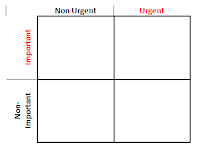
Somedays, the to-do lists are too full of random and uninspiring tasks. It becomes too easy to procrastinate. I've tried the four quadrant tactic -- the one that plots to-do activities on a matrix of important-to-less important and urgent-to-less urgent. And while I haven't given up on it yet, I always seem to do only what is urgent anyway.
So I've decided to try and motivate myself by getting rid of the important/less-important column and replace it with Fun/not-Fun. In addition to having more fun keeping the chart updated, it should be even easier to plot items using urgent and fun, rather than sorting the important from the urgent, which are too often the same! Now, if I can just discipline myself to do one Non-Fun task before each Fun item, I should double my productivity! Since not all work nor all personal tasks fall in once category, I'm hoping to have more fun getting more stuff done in all quadrants.
The new goal will be to have more fun items than not-fun items, so that when all the non-fun items are done, I can just do more fun things. That sounds rewarding.
However since blogging is decidedly fun, I'd better now go do something not quite as fun!